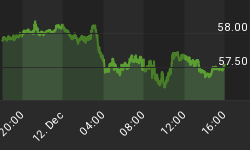The price action the past several weeks has been poor, and key price levels are now being challenged and violated. Key price levels are the best areas of support (buying) and resistance (selling). In essence, support levels are being broken, and this doesn't bode well for the equity markets.
Figure 1 is a weekly chart of the S&P Depository Receipts (symbol: SPY). The red dots on the price bars are the key pivot levels. A weekly close below 126.89 would be consistent with bear market price action. In essence, prices should not close below support. Of note, back on June 19, 2011, I was bullish as investors had clearly turned bearish. I would close out this position this Friday if the SPY closed below the 126.89 key pivot level. Yes, the position would yield a small loss. Hey, you cannot win them all, but if you don't play, then there is no pay.
More importantly for the equity markets, a bull signal (i.e., too many bearish investors) that fails to lead to a bear signal (i.e., too many bullish investors) has a high likelihood of seeing lower prices. As discussed in the article, "Equities: What's Next?": "Extremes in bearish sentiment don't always lead to extremes in bullish sentiment, and in fact, it only happens about 50% of the time. So what happens when the "dumb money" indicator rolls over? 15 out of the 22 trades turn out to be losers."
Figure 1. SPY/ weekly
Figure 2 is a weekly chart of the PowerShares QQQ Trust Series (symbol: QQQ). This ETF proxy for the NASDAQ100 has been a relative out performer as prices are well above the key support level at 53.95. Of note, our June 19 buy signal had us in the markets at 53.66.
Figure 2. QQQ/ weekly
Figure 3 is a weekly chart of the S&P Select Financial Spider Fund (symbol: XLF). The "key" banking sector is breaking down and prices appear likely to close below the week below the key pivot point at 14.76. This level becomes resistance.
Figure 3. XLF/ weekly
















